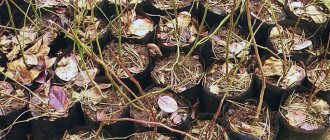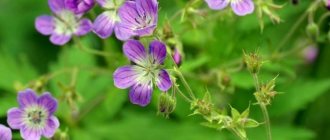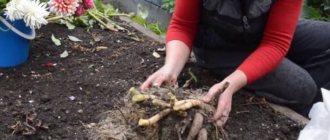The perennial iris flower (also called iris or cockerel) has many varieties that differ from each other in the shape and color of the inflorescences. This plant is easy to care for, making it popular with many summer residents. But not everyone knows how to preserve irises before planting, or rather the bulbs of this flower. We’ll talk about this today in our review.
How to choose
To choose good planting material, you should know what a high-quality, healthy iris rhizome looks like. You should definitely pay attention to the fact that the rhizome must have:
- solid, elastic structure, absence of traces of mold and disease;
- juicy living roots (when they dry out, they become like threads);
- the cuttings remaining after cutting the leaves should have a green color.
The presence of brown spots on the remaining parts of the leaves may be an indicator of plant disease, but this is not critical. Fungicide treatment will help solve this problem. It is much worse if the base of the leaves turns yellow. Such a layer will not be able to overwinter normally before planting, or will then not take root in the new conditions.
Protection from diseases and pests
For full flowering and protection from diseases (fusarium, botrytis, heterosporiosis, etc.), it is necessary to provide irises with a balanced diet and regularly use fungicides. Crop rotation, rejuvenation of old plants and good ventilation in sparse plantings are also very important for the successful cultivation of irises. In mid-April, after removing the cover, I clear the plants of dry leaves, pour a solution of calcium nitrate from a watering can (25–30 g per 10 liters of water), and spray with any of the copper-based preparations. At the beginning of June, I add potassium monophosphate by watering with the prepared solution (10 g per 10 liters of water). Both fertilizers mentioned have almost no effect on the acidity of the soil and are quickly absorbed by the superficial root system of irises. Two to three weeks after flowering, irises begin to actively grow lateral links and it’s time to feed them with nitrogen in ammonium form. I carefully clean and remove the yellowed leaves, use a sponge to scrape away the soil from the “backs” of the rhizomes, and trim the tips of the leaves damaged by spotting to healthy tissue. I feed adult plants with a mixture of crushed chalk and ammonium sulfate (1:1) at the rate of 25–30 g per plant. It is better to fertilize young divisions and lagging irises by scattering wood or grass ash a tablespoon per planting unit. Irises react positively to the addition of microelements, and I spray the plantings a couple of times with a solution of nitrogen-free fertilizer “Siliplant”. This product with active silicon will be very useful in warm, rainy weather, when nutrients are quickly washed out of the soil. In August, on poor soils, it is recommended to apply high-quality autumn mineral fertilizer with a high content of phosphorus and potassium, but it will dissolve only with periodic moistening. In the summer, to prevent fungal diseases, I use biological products (“Alirin”, “Fitosporin”, “Gamair”, etc.), and if spotting is detected on the leaves, I immediately treat it with “Oxychom”, “Homoxyl” or, in severe cases, with colloidal sulfur. Insect pests do not bother my irises, but in dry and hot weather thrips may appear. This year we managed to easily get rid of these insects using regular Karbofos. I sprayed the plants and the soil around them three times at an interval of five days. In general, if we formulate a brief general rule for caring for irises, it will turn out like this: “cleaning - preventive treatment - moderate feeding.” Irises love delicate handling: careful loosening and weeding, careful cleaning and pruning with mandatory disinfection of tools. In autumn, it is better not to disturb the irises again, so as not to damage the roots. Although I, a lover of cleanliness and order, find it very difficult to follow this recommendation. But it’s better to let the nasty dandelions overwinter under cover than for an accidentally wounded valuable and beloved variety to rot.
In conclusion, I cannot deny myself the pleasure of showing off several varieties from the Cayeux nursery that bloomed for the first time this year. “Andalou” (“Andalou”, Cayeux, 1995) is a profusely flowering variety of bright contrasting color with rich yellow standards and red-brown fouls. The variety is noticeably characterized by rapid growth, so I plan to propagate it and plant it in a separate expressive group. The ideal pair in terms of color combination and flowering time was obtained from the varieties “Bientot l'Ete” (“Bianto Lethe”, Cayeux, 2015) and ‘Big Dipper” (“Big Dipper”, Braun, 1981). Iris “Bientot l'Ete” closes the bloom show and displays vibrant flowers with dense petals. The radiant yellow color of the standards of this variety is impressively complemented by the violet-blue edging on the almost horizontal fouls. Durable peduncles of medium height are decorated with 7–8 buds and can withstand even heavy rain. When the famous “red” iris “Rip City” (“Rip City”, Schreiner, 1999) first bloomed, I liked not so much the expressive crimson-red color as the luxurious shape of the flower. Standards with large waves along the edge form a lush “crown”, which, in combination with the noble color, gives the flower a real “royal” look. I consider the iris “Ma Pomme” (“Ma Pom”, Cayeux, 2011) to be one of the best varieties with a uniform color, which has a lot of advantages. The large, ruffled petals are a soft apricot-orange color that shows a subtle coppery glow in sunlight, and the flowers themselves are quite large and beautifully shaped. This variety will be very good in a composition with pink irises in pastel shades, for example with “Rose de la Vallee”, “Subtilite” or “Remy Belleau”. The debut flowering of the “Safari Sunset” variety (“Safari Sunset”, Blyth, 2001) made a very unexpected impression. When a flower of an unusual terracotta color opened among the cut irises, an association arose with the shades of red sand in the Jordanian desert, illuminated by the last rays of the setting sun. Terracotta large flowers look natural, but at the same time elegant, and as partners for the composition I dream of getting the varieties “Tabac Blond” (“Taba Bleu”), “Lovely Senorita” (“Lovely Senorita”) or the stunning “Reflets du Sol” ” (“Refle Du Sol”). The effect of the first flowering of the iris “Domino Noir” (“Domino Noir”, Cayo, 2012) was expected, because the variety has a unique color. The flower follas are black-violet, velvety, and the standards are white with a light cold-violet shadow. But the main feature of the variety is the thin and clear edging on the top of the flower. The contrast of black and white is mesmerizing, and the iris looks solemn and luxurious. In addition to the laconic coloring of large flowers and the tall growth of peduncles, the “Domino Noir” iris has other advantages: it grows well and blooms for longer than two weeks, even in hot weather. Now this amazing iris is the best in my small collection of fifty varieties and my favorite. Irises are plants that are responsive to care and attention, and there is no need to “tame” them. The main thing is to understand under what conditions these “Spartans” will be comfortable. Failure to comply with basic rules of agricultural technology or, conversely, excessive zeal can delay the flowering festival. Blooming irises are a miracle that is a generous compensation for the efforts, worries and troubles.
Subscribe to our newsletter to be the first to know about new articles and promotions!
When and how to dig and prepare for storage
It is considered normal for the iris to grow in one place for 6 to 7 years, after which it requires replanting. But the type of flowers is of great importance. For example, Japanese iris needs to be replanted within 2–3 years. And Siberian can grow in one place for 10 years.
Whether or not to dig up these plants for the winter will depend on the region where they grow. In the southern regions, where winters are not too cold, it is enough to simply insulate the flowers. They are covered with coniferous branches, and the soil is pre-mulched (covered with some kind of material).
In places where the soil freezes heavily in winter and little snow falls, it is better to dig up flowers. This is done 4 weeks after flowering ends. And prepare for storage as follows:
- Remains of soil are removed from the rhizomes;
- wash the material under running water;
- flowers are sent to dry. The optimum temperature should be around +23°C. The room must be well ventilated. The rhizomes should be dried for 25 days.
Cutting areas on leaves and rhizomes must be treated. To do this, use colloidal sulfur or crushed coal. This treatment will help prevent plant rotting.
It is best to plant bearded irises in open ground in mid-August. Then they will have time to adapt to new conditions before the onset of cold weather, and will be able to overwinter normally.
If the planting time in August was missed for some reason, it is possible to do it in the spring, when the soil has warmed up well.
What affects shelf life
The safety of seed material is influenced by the following factors:
- Harvesting and transplanting time . Most varieties need to be replanted after 6-7 years, Japanese - after 2-3 years, Siberian - after 10 years.
- Date of procurement of seed material . It is important to choose the right moment for digging. This is influenced primarily by climate.
- Correct processing before storage.
- Temperature . Must be in the range 0°С-+4°С.
- Humidity . Some varieties, such as Japanese, Louisiana and Siberian iris, require more moisture.
- Quality of material . The bulbs should be dense and healthy.
Types of storage
After the bulbs are dried, they are placed in layers in previously prepared containers and each of them is sprinkled with sand. Holes for ventilation are first made in the containers. Instead of sand, it is permissible to use peat, sphagnum moss or sawdust.
Irises can be stored in paper bags, or simply wrapped in several layers of newspaper. Each rhizome must be wrapped individually in paper. After this, the rhizomes are placed in a cardboard box.
You cannot use plastic bags or cling film to store roots. In such conditions, the planting material will quickly become damp and covered with mold.
Before storing irises before planting, you need to find a suitable room for them that will be dry and cool.
The storage temperature for irises from autumn until spring planting should be from 0°C to + 4°C. Such conditions are possible on a glazed loggia, in a cellar or basement. If you have free space in the refrigerator, it is possible to store irises there before planting. It is best to keep bearded irises in the vegetable compartment of the refrigerator.
Spring planting of irises in open ground occurs after the soil has warmed to +11°C.
Japanese, Siberian, and Louisiana iris are moisture-loving plants. They are stored in flower pots sprinkled with earth. The roots are first lightly trimmed, treated with a solution of potassium permanganate and dried in the sun. Spring planting of these flowers occurs directly with a lump of earth. This way the plant will retain moisture and be able to adapt normally to new conditions.
Garden care for bulbous irises
Irises are truly beautiful flowers, but in order for them to begin decorating the garden with their bright appearance, the flowers need to be properly cared for.
Lighting, temperature and humidity
Bulbous irises prefer to grow in well-lit areas, which must be taken into account when choosing a site for planting. The ideal place for growing would be an area that is well lit by the sun. In the absence of such a flowerbed, you can organize it in small partial shade. The flower is a heat-loving plant and does not survive the winter period well.
Flowers do not like excessive moisture and stagnant water, so to prevent rotting, the soil in which the bulbs will be planted is drained. It is not advisable to plant bulbs in soil with groundwater, since the plant will die due to excess moisture.
The soil
The ideal soil would be sandy, light and well-fertilized soil. The soil must be drained and nutritious. To fertilize the soil, humus or ash is usually used. Some gardeners add chernozem to insufficiently nutritious soil when planting plants.
Once the flower takes root, it will be able to extract nutrients even in infertile soil.
Watering and fertilizing
In spring, flowers require regular watering, especially in drought conditions. But in the summer, these plants begin a dormant period, so the bulbs must be kept in a dry and warm environment. If the summer promises to be wet, then it is best to cover the area with plants with a film, it will not allow moisture to enter the soil.
Feed the plant several times a year. The choice of fertilizer depends on the type of soil in which the flower was planted. As a rule, old humus without organic matter is used. You can also fertilize the area with superphosphate or compost. You need to add sand to clay soil to make it lighter.
The first fertilizer is applied during planting, the second time it is best to fertilize it a week before flowering. The last feeding is best done a few weeks after flowering. When feeding the plant, the main thing is not to overdo it with fertilizers with a high nitrogen content, since its excess will give an impetus to the growth of leaves and will become an obstacle to the appearance of buds.
Winter care
Iridodictiums and junos tolerate winter much easier than xyphiums. If varieties belonging to the first two types can simply be covered with a layer of spruce branches, fallen leaves or lutrasil, then the latter require autumn digging. The dug up bulbs are stored in a cold place, protected from moisture and bright light, where the air temperature does not fall below 5 degrees. The ideal location would be a moisture-proof basement or the bottom shelf of the refrigerator.
It will also be interesting: Lilies OT-hybrids - varieties, names, description, planting and care
Proper cutting of flowers
How to keep irises in a vase for as long as possible? First of all, you need to choose the right moment to collect them. This should be done in the absence of the sun: early in the morning or late in the evening. If the weather is cloudy but dry, you can cut irises during the day.
Flowers picked in the rain quickly darken and wither. This is facilitated by excess moisture that accumulates in the petals.
In order to store irises in a vase for as long as possible, a number of conditions must be met:
- You need to cut only those flowers whose buds have a bright, uniform color;
- the stem cut should be located as close as possible to the rhizome;
- Before placing it in a vase, the cut location on the stems is updated (it is made long, diagonally);
- Boiled water is poured into the vase, at a temperature slightly above room temperature.
You can store irises in a vase for 10 days. If some flowers begin to fade, they are removed from the overall bouquet.
Landing
Planting irises is simply pressing the prepared rhizome into the ground two-thirds of its height, but at a slight angle towards the fan of leaves. If the plot is small, then in heavy rain it can simply be carried away or turned over, so it is better to root the irises in a container. Now I practice growing “babies” or irises of valuable varieties in pots filled with light soil and buried in the greenhouse. This method is excellent for irises purchased in mid-autumn, when the formation of a good root system is very important. When planting in summer, I prefer to secure the rhizome with a stone or a braided wire staple. When rooting, you need to water very moderately, just to moisten the top layer of soil. The use of root formation stimulants significantly accelerates the formation of a developed root system. Some time after transplantation, the irises begin to grow rhizomes, and young leaves grow in the center of the fan. At this time, it is better to carefully remove yellowed leaves that die as they grow and make sure that the “back” of the rhizome remains open.
How to preserve a bouquet of cut irises
You cannot immediately place the bouquet in a vase. He needs time to get used to the surrounding temperature. Millet flowers are placed in a dark corner and left untouched for 15 to 20 minutes.
A vase for these flowers is used with a wide neck. It is filled one third with cold water. There is no need to add more water to prevent the leaves of the plants from becoming moldy.
An oblique cut on the stems should be made under water so that air does not get into them, which will interfere with the normal flow of moisture to the buds.
Arrows and leaves with signs of wilting should be removed . They are cut to the ground using a sharp knife or blade. If this is not done, they will quickly rot in the water, forming a large amount of mucus. The liquid will not be able to flow normally through the stems, and the bouquet will dry out within a day.
Replacing the water in the vase with fresh water is required every day, and the vase is washed well. You can moisten the buds using a spray bottle. This imitation of dew refreshes flowers and humidifies the air.
Storage of cut irises should occur:
- at temperatures up to +20°C;
- away from heat sources and drafts;
- in a place protected from sunlight.
Such conditions will allow you to preserve the irises for as long as possible, and will prevent the flowers from drying out due to loss of moisture.
Caring for a plant at home
Unpretentious bulbous bulbs are the first to delight us in the spring, so many people strive to plant them at home. And at the same time, they are content with a very small list of rules for care at home.
Lighting, temperature and humidity
Dutch iris likes sunny, dry places. It can be planted in open meadows, or at least near those plants that in the spring do not yet have time to grow and greatly shade the space, but simply create a light screen.
After digging, drying is already carried out at a good +30, they can be obtained in recent years of climate change or in cool summers - in the attic, under the roof. In winter, the bulbs will benefit from a slight minus. Air humidity is not so critical for them, except that its excess, stagnation of rainwater and cold temperatures can provoke rot.
Watering and fertilizing
Usually in the spring during growth and flowering there is enough moisture for Xyphium, so additional watering is not needed. Especially if there is mulch that collects and stores dew. It only needs to be watered during dry periods in summer.
At the same time, the soil is very important; if it is not clayey, but permeable and loose, everything will be fine with the flower garden.
Bulbs do not need large doses of fertilizers, especially during the flowering period. Before planting, it will be enough to make the soil nutritious and sometimes add wood ash, compost or humus. One of the feedings is carried out when thickenings on the flowering stems - future buds - become visible.
Preparing for winter
After the end of the flowering period, the plant still stands for some time with green leaves, which die off closer to the second half of summer. When the above-ground part has completely disappeared, the bulbs should be dug up to dry in preparation for winter. In this case, you can separate the babies for reproduction from the common nest, or you can leave them attached for several seasons until the small bulbs grow up.
The bulbs need to be dried in a warm and dark place for 2-4 weeks, and then stored in dry, ventilated boxes with moss or sawdust until October.
Then plant according to all the rules and cover with leaves, you can even use spruce branches if a harsh winter is expected. In some regions with particularly harsh winters, they are not planted in the fall, but stored until spring.
But still, it is much more logical for the bulb to survive the winter outside, without losing its natural rhythm. By the way, small new bulbs will survive winter much easier in the future if they are initially familiar with it and not grown in greenhouses for sale. Your newly made bulbs will already be adapted.
It will also be interesting: Neomarica (walking iris) - care at home?
Water requirements
Without water, a cut iris will dry out very quickly, and an excess of moisture will lead to mold and rotting of the plant. Therefore, do not pour too much water into the vase.
There are additives that help extend the freshness of cut flowers. These include:
- citric acid (3 – 4 g per 1 liter of water);
- granulated sugar (2 tbsp per 1 liter of water);
- hydroxyquinoline sulfate (a substance that protects against plant diseases).
To prevent stem rotting, place in the vase:
- copper wire;
- silver item;
- charcoal (small piece).
You can buy Chrysal plant food at a florist store and add it to the water according to the instructions.
Feeding irises
Although any plant needs nutrition, flowers need it more urgently. Active growth of green mass in spring and large flowers appearing in summer require systematic feeding. The first is carried out immediately after the snow cover melts and the ground partially dries out. In different regions, the first feeding will be carried out at different times, approximately from February to April.
Feeding irises in spring and summer is intended to ensure lush flowering, as well as prepare the plant for wintering. Moreover, in summer, fertilizers are applied only on soils that are too depleted.
In early spring, irises will actively grow green mass, so the plants need nitrogen fertilizers. Magnesium and other trace elements will contribute to the synthesis of chlorophyll. The following is additionally added to the wet soil:
- potassium or ammonium nitrate;
- well-rotted compost;
- complex mineral supplements.
Nitrogen supplements are added at the rate of 1 tablespoon per bush. In order for the fertilizer to be better absorbed, it is diluted in warm water and each plant is watered. If shelter was not used for wintering, the fertilizer can be spread on the snow next to the bushes. Spreading fertilizers on dry soil is strictly not recommended. This can lead to root burns. When using compost, the fertilizer is spread in a small layer under the leaves.
During the period of bud formation and flowering, irises need a lot of energy. Accelerated metabolism is provided by potassium-phosphorus supplements. Agrofoska contains both elements, which is why it is popular among gardeners.
You can mix a potassium-phosphorus cocktail yourself, using materials available on the farm. The source of phosphorus can be bone meal processing products - simple or double superphosphate. This fertilizer is less soluble than nitrogen fertilizers, so it is recommended to apply them in shallow grooves.
The following will help provide flowers with potassium:
- sylvinite;
- potassium sulfate;
- stove ash.
Potassium salts are added at the rate of 1.5 tablespoons per square meter of flower bed. After applying the fertilizer, the soil is watered abundantly.
The last feeding is carried out after the flowers have completely withered. An important rule for applying fertilizers during this period is the complete absence of nitrogen. This is not advisable, since autumn rains will wash it away from the surface, carrying it into the deeper layers of the soil. The element also causes active growth of greenery. This can lead to disruption of the natural rhythm and freezing of the bush in winter.
Phosphorus and potassium added closer to autumn will provide immunity to irises before wintering and will help lay strong flower buds for the next season. By adding a few grams of sulfur to the fertilizer, it is easy to provide additional disinfection of the bush.
Transplantation and propagation of irises
After the irises have bloomed, you can begin replanting them so that the plants have time to take root before the onset of cold weather. Your “new settlers” will begin to bloom in the second or third year after transplantation. Experts advise dividing and replanting irises at least once every 5 years so that the rhizome is not pushed to the soil surface, which in turn can lead to a lack of buds and a reduction in the flowering of irises. Replanting takes place in a prepared area, where the soil has been previously dug up along with mineral fertilizers.
Irises can be propagated by seeds or vegetatively, although seeds are mainly used only to obtain a new variety.
The most common method is the vegetative method, which has undeniable advantages:
– versatility, can be used for both varietal and wild species;
– the next year the irises begin to bloom.
The success of the vegetative method directly depends on the “parent”, so it is very important to choose a strong and healthy plant. Having cleared the roots of excess soil, you should divide the bush so that each separate part has its own piece of the root system and a bunch of leaves. Then the roots should be cut by a third, and the leaves by half, removing dry leaves and damaged roots. The next stage is disinfection by immersing the iris in a weak manganese solution for 15 minutes, drying it in the sun and treating the cut with a composition of sulfur and crushed coal. The prepared planting material must be lowered into a hole dug with a slight elevation in the center, the root system carefully spread on the mound, sprinkled with earth and lightly trampled.
Experts advise pointing the heel of the fan in a southerly direction when planting so that it can warm up in the sun without being shaded by iris leaves. Afterwards, water well, and until complete rooting it should be watered every 3-5 days, water consumption should be adjusted according to the weather. When planting several irises, a distance of up to half a meter should be maintained between them. When planted correctly, the iris grows with a slight slope and maintains an upright position when lightly tapping the leaves. The fan of the plant can be temporarily fixed with a wire clip, which can be removed after rooting.
If you do not grow planting material yourself, then to purchase better quality, you need to contact trusted suppliers or specialized stores. When purchasing planting material, you should first examine the size of the rhizome. It is believed that the larger the rhizome, the more useful reserves it has accumulated, and accordingly, the better and faster the “newbie” will take root in a new place.
It is also worth paying attention to the number of leaves, the presence of at least 7, shows that the plant can bloom in the spring of next year. When purchasing a rhizome whose roots and leaves have been trimmed, you should know that it can be stored for no more than two weeks, and in no case should it be placed in a plastic bag. Also, do not store planting material in damp cloth. Experts advise never to save on planting material, so that there is no bitter disappointment in the final result, including wasted labor and material costs.











